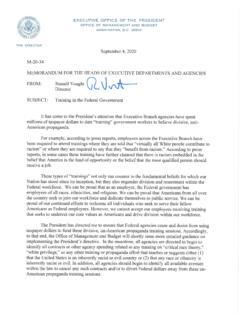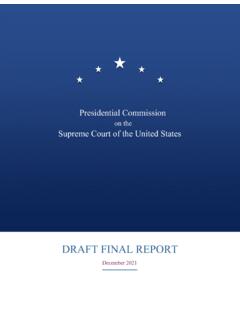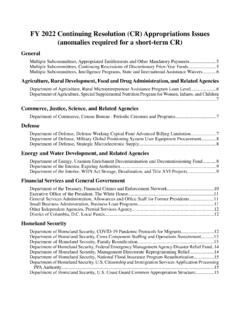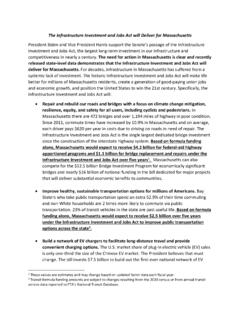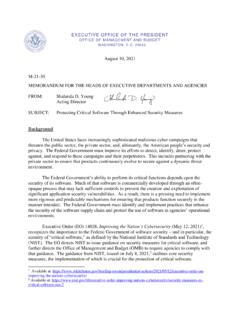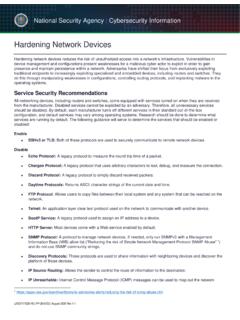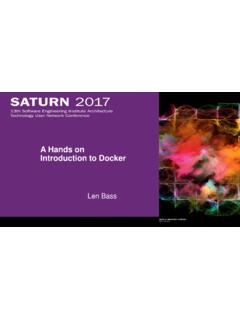Transcription of OFFICE OF MANAGEMENT AND BUDGET
1 EXECUTIVE OFFICE OF THE PRESIDENT O F F I C E O F M A N A G E M E N T A N D B U D G E T W A S H I N G T O N , D . C . 2 0 5 0 3 January 26, 2022 M-22-09 MEMORANDUM FOR THE HEADS OF EXECUTIVE DEPARTMENTS AND AGENCIES FROM: Shalanda D. Young Acting Director SUBJECT: Moving the Government Toward Zero Trust Cybersecurity Principles This memorandum sets forth a Federal zero trust architecture (ZTA) strategy, requiring agencies to meet specific cybersecurity standards and objectives by the end of Fiscal Year (FY) 2024 in order to reinforce the Government s defenses against increasingly sophisticated and persistent threat campaigns. Those campaigns target Federal technology infrastructure, threatening public safety and privacy, damaging the American economy, and weakening trust in Government. day, the Federal Government executes unique and deeply challenging missions:agencies 1 safeguard our nation s critical infrastructure, conduct scientific research, engage in diplomacy, and provide benefits and services for the American people, among many other public functions.
2 To deliver on these missions effectively, our nation must make intelligent and vigorous use of modern technology and security practices, while avoiding disruption by malicious cyber campaigns. Successfully modernizing the Federal Government s approach to security requires a Government-wide endeavor. In May of 2021, the President issued Executive Order (EO) 14028, Improving the Nation s Cybersecurity,2 initiating a sweeping Government-wide effort to ensure that baseline security practices are in place, to migrate the Federal Government to a zero trust architecture, and to realize the security benefits of cloud-based infrastructure while mitigating associated risks. 1 As used in this memorandum, agency has the meaning given in 44 3502. 2 Exec. Order No. 14028, 86 Fed. Reg. 26633 (2021). 2 II. EXECUTIVE SUMMARY In the current threat environment, the Federal Government can no longer depend on conventional perimeter-based defenses to protect critical systems and data.
3 As President Biden stated in EO 14028, Incremental improvements will not give us the security we need; instead, the Federal Government needs to make bold changes and significant investments in order to defend the vital institutions that underpin the American way of life. A transition to a zero trust approach to security provides a defensible architecture for this new environment. As described in the Department of Defense Zero Trust Reference Architecture,3 The foundational tenet of the Zero Trust Model is that no actor, system, network, or service operating outside or within the security perimeter is trusted. Instead, we must verify anything and everything attempting to establish access. It is a dramatic paradigm shift in philosophy of how we secure our infrastructure, networks, and data, from verify once at the perimeter to continual verification of each user, device, application, and transaction. This strategy envisions a Federal Government where: Federal staff have enterprise-managed accounts, allowing them to access everything they need to do their job while remaining reliably protected from even targeted, sophisticated phishing attacks.
4 The devices that Federal staff use to do their jobs are consistently tracked and monitored, and the security posture of those devices is taken into account when granting access to internal resources. Agency systems are isolated from each other, and the network traffic flowing between and within them is reliably encrypted. Enterprise applications are tested internally and externally, and can be made available to staff securely over the internet. Federal security teams and data teams work together to develop data categories and security rules to automatically detect and ultimately block unauthorized access to sensitive information. This strategy places significant emphasis on stronger enterprise identity and access controls, including multi-factor authentication (MFA). Without secure, enterprise-managed identity systems, adversaries can take over user accounts and gain a foothold in an agency to steal data or launch attacks. This strategy sets a new baseline for access controls across the Government that prioritizes defense against sophisticated phishing, and directs agencies to consolidate identity systems so that protections and monitoring can be consistently applied.
5 Tightening access controls will require agencies to leverage data from different sources to make intelligent decisions, such as analyzing device and user information to assess the security posture of all activity on agency systems. 3 Department of Defense (DoD) Zero Trust Reference Architecture, (U) (U) 3 A key tenet of a zero trust architecture is that no network is implicitly considered trusted a principle that may be at odds with some agencies current approach to securing networks and associated systems. All traffic must be encrypted and authenticated as soon as practicable. This includes internal traffic, as made clear in EO 14028, which directs that all data must be encrypted while in transit. This strategy focuses agencies on two critical and widely used protocols in the near-term, DNS and HTTP traffic;4 in addition, the Cybersecurity and Infrastructure Security Agency (CISA) and the Federal Risk and Authorization MANAGEMENT Program (FedRAMP) will evaluate options for encrypting email in transit.
6 Further, Federal applications cannot rely on network perimeter protections to guard against unauthorized access. Users should log into applications, rather than networks, and enterprise applications should eventually be able to be used over the public internet. In the near-term, every application should be treated as internet-accessible from a security perspective. As this approach is implemented, agencies will be expected to stop requiring application access be routed through specific networks, consistent with CISA s zero trust maturity In addition to robust internal testing programs, agencies should scrutinize their applications as our nation s adversaries do. This requires welcoming external partners and independent perspectives to evaluate the real-world security of agency applications, and a process for coordinated disclosure of vulnerabilities by the general public. This strategy also calls on Federal data and cybersecurity teams within and across agencies to jointly develop pilot initiatives and Government-wide guidance on categorizing data based on protection needs, ultimately building a foundation to automate security access rules.
7 This collaborative effort will better allow agencies to regulate access based not only on who or what is accessing data, but also on the sensitivity of the data being requested. Transitioning to a zero trust architecture will not be a quick or easy task for an enterprise as complex and technologically diverse as the Federal Government. The strategy set forth in this memorandum is designed to reduce uncertainty and outline a common path toward implementing EO 14028, by updating and strengthening information security norms throughout the Federal enterprise. III. ACTIONS While the concepts behind zero trust architectures are not new, the implications of shifting away from trusted networks are new to most enterprises, including many agencies. This process will be a journey for the Federal Government, and there will be learning and adjustments along the way as agencies adapt to new practices and technologies. Agencies that are further along in their zero trust process should partner with those still beginning by exchanging information, playbooks, and even staff.
8 Agency Chief Financial 4 DNS is the internet s Domain Name System, and in this context refers to the protocol used to look up the internet protocol (IP) address of a given hostname ( ). HTTP stands for Hypertext Transfer Protocol, and is the primary protocol used to serve web content, as well as other internet data. 5 CISA, Zero Trust Maturity Model, 4 Officers, Chief Acquisition Officers, senior agency officials for privacy, and others in agency leadership should work in partnership with their IT and security leadership to deploy and sustain zero trust capabilities. It is critical that agency leadership and the entire C-suite be aligned and committed to overhauling an agency s security architecture and operations. Agencies should make use of the rich security features present in cloud infrastructure. This strategy frequently references cloud services, but also addresses on-premise and hybrid systems.
9 Although this memorandum directs agencies to the highest-value starting points on their path to a zero trust architecture, and describes several shared services which should be prioritized to support a long-term Government-wide effort, this strategy is a starting point, not a comprehensive guide to a fully mature zero trust architecture. In planning and executing their long-term security architecture migration plans, agencies can reference the comprehensive maturity models and reference architectures provided in Appendix A. This memorandum requires agencies to achieve specific zero trust security goals by the end of Fiscal Year (FY) 2024. These goals are organized using the zero trust maturity model developed by CISA. CISA s zero trust model describes five complementary areas of effort (pillars) (Identity, Devices, Networks, Applications and Workloads, and Data), with three themes that cut across these areas (Visibility and Analytics, Automation and Orchestration, and Governance).
10 The strategic goals set forth in this memorandum align with CISA s five pillars: 1. Identity: Agency staff use enterprise-managed identities to access the applications they use in their work. Phishing-resistant MFA protects those personnel from sophisticated online attacks. 2. Devices: The Federal Government has a complete inventory of every device it operates and authorizes for Government use, and can prevent, detect, and respond to incidents on those devices. 3. Networks: Agencies encrypt all DNS requests and HTTP traffic within their environment, and begin executing a plan to break down their perimeters into isolated environments. 4. Applications and Workloads: Agencies treat all applications as internet-connected, routinely subject their applications to rigorous empirical testing, and welcome external vulnerability reports. 5. Data: Agencies are on a clear, shared path to deploy protections that make use of thorough data categorization. Agencies are taking advantage of cloud security services to monitor access to their sensitive data, and have implemented enterprise-wide logging and information sharing.


